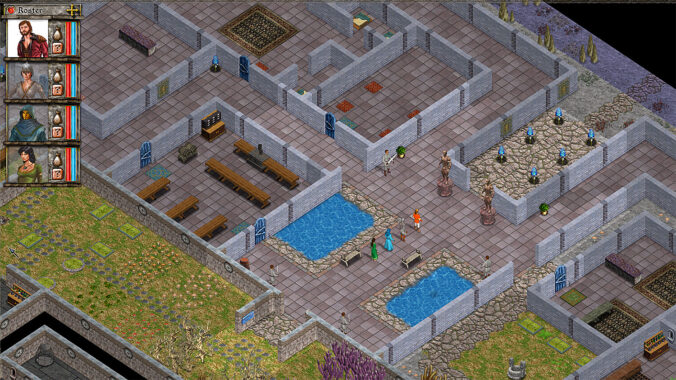Next on my adventures into old CRPGs, I got into the Avernum Trilogy, by Spiderweb Software. I never played the original Exile series from the 1990s, but I did play the remake series, renamed Avernum, six games published from 2000 to 2009. However, those games no longer work on new computers. Fortunately, Jeff Vogel (owner of Spiderweb Software) has been launching new remakes of the series, and the first trilogy is already available. All these games are deeply rooted in traditional CRPG design, featuring turn-based combat, non-linear storytelling, and a vast, immersive underground world.
In Avernum: Escape from the Pit (2011), the player assumes the role of a group of prisoners exiled into the vast subterranean realm of Avernum, a cavernous world beneath the surface controlled by the tyrannical Empire. Unlike many CRPGs where the protagonist is a chosen hero, Escape from the Pit presents a world where survival is the first goal, and grander ambitions unfold naturally.
Thematically, the game explores oppression, resistance, and exile, drawing from dystopian fiction and the American frontier myth. The player’s choices (to merely survive, seek revenge, or escape) create a sense of agency, though the narrative structure remains relatively fixed. As expected from an independent game, the graphics are simple but very functional.
The game retains Spiderweb’s signature turn-based combat and isometric, grid-based exploration. It features deep tactical gameplay with a variety of abilities and skills. Character progression is robust, offering numerous build options. For this run, my group of four adventurers consisted of two dual-wielding fighters in the front and an archer and a priest/mage hybrid in the back. It was not the most efficient formation but it was fun to play. Magic users become very powerful around the middle of the game, so a group of mages and priests would have been a much stronger choice.
The underworld of Avernum is vast and interconnected, filled with hidden ruins, cities ruled by desperate exiles, and factions vying for dominance. The sense of discovery (finding lost vaults, encountering strange cave-dwelling races, or unearthing the history of Avernum) makes exploration very satisfying.
Avernum II: Crystal Souls (2015) was my favorite in the trilogy. It builds upon its predecessor by escalating the stakes and presenting a full-scale war between Avernum and the Empire, with the alien-like Vahnatai acting as an unpredictable third force. In the previous game we got hints of the existence of this ancient people, and meeting them here and learning about their culture deepens the world’s lore, bringing elements of lost civilizations and enigmatic magic into play.
Themes of war, diplomacy, and cultural misunderstanding drive the story. The presence of the Crystal Souls, ancient Vahnatai artifacts stolen by humans, introduces a compelling central conflict that asks whether peace is even possible or if mutual destruction is inevitable.
For this game, based on the previous experience, my group of four adventurers consisted of just one dual-wielding fighter, one priest, and two mages (who dealt an absurd amount of damage with their area of effect spells).
Avernum II: Crystal Souls is a step up from its predecessor in terms of complexity and scope. The story is stronger, the world more developed, and the choices feel more impactful. It stands as the most substantial narrative experience in the trilogy.
Avernum III: Ruined World (2018) tried to be more ambitious but didn’t fully succeed. It takes the series in a different direction by allowing players to go to the surface world for the first time, a land now devastated by an unknown menace. Instead of fighting for survival in the underworld, the game shifts to a post-apocalyptic tone, where players must navigate a collapsing Empire.
The problem was that, instead of the well developed and unique settlements we can visit in the previous games, what we find in the surface world are very generic towns with very generic inhabitants. For example, while we were used to named NPCs with their own back stories populating the towns, here we have the same merchants (blacksmith, weaver, etc) appearing in any town you go and having the same dialogue lines. It feels very repetitive, almost like the developers didn’t have enough time to properly populate the large number of settlements in the game.
The game’s central theme is civilization in decline. And if you take too long to solve the mysteries and complete your missions you will see towns destroyed, refugees fleeing, and the slow encroachment of a new alien threat. Unlike its predecessors, which are tightly structured, Ruined World is more open-ended, allowing players to shape the fate of the surface world through their actions. This new direction enhances player agency, but it also creates pacing issues. The urgency of the disaster can clash with the open-world exploration, making it easy to miss key story beats.
The party I used in Avernum II was so successful that I followed the same structure in Avernum III: one dual-wielding fighter, one priest, and two mages. And I advanced in the main quest as fast as I could, trying to prevent too much destruction to the surface world. Although this strategy worked well, it left me with the sensation that I didn’t explore the game world as well as I wished.
The shift to the surface is both a strength and a weakness. The devastated world is compelling, but lacks some of the uniqueness that made Avernum‘s underground setting so engaging. The world is more reactive than in previous games, but it can feel a bit overwhelming and unfocused compared to the tighter narrative of Crystal Souls.
I did enjoy replaying the Avernum trilogy. It excels in worldbuilding, tactical combat, and non-linear storytelling. While Escape from the Pit sets the stage with a strong survival narrative, Crystal Souls delivers the best story and character depth. Ruined World is the most mechanically ambitious, but its sprawling open-world design can dilute its storytelling.
